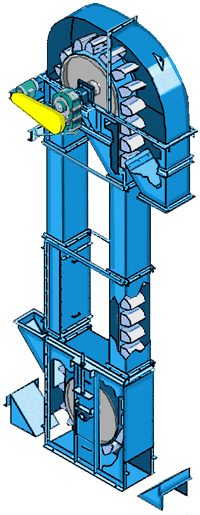What is a bucket elevator?
Moreover, bucket elevators are widely used in the cement industry. Their small footprint, simple structure, large capacity, high lifting height, and low energy consumption contribute to their popularity. They are critical at different stages, including raw material storage, transportation, grinding systems, clinker feeding, cement grinding, and packaging. In modern large-scale cement production lines, bucket elevators are vital components in key positions.
Nantong Darko’s Expertise
Nantong Darko has ten years of experience in machinery manufacturing. We use advanced design principles to create our products. We also select high-quality steel and components. Additionally, we strictly control manufacturing precision to ensure reliable operation of our bucket elevators. Our product range includes NE type, TD type, TH/HL type, and dewatering scooping bucket elevators.
Classification of Bucket Elevators
1. By Layout
Vertical: The most common layout for conveying materials straight up.
Inclined: Suitable for scenarios requiring material elevation at a certain angle.
2. By Discharge Method
Centrifugal: Utilizes centrifugal force for discharge, suitable for conveying small, free-flowing materials, such as dry powders.
Gravitational: Relies on the weight of the material for discharge, suitable for large, heavy, and abrasive materials like ores and stones.
Mixed: Combines characteristics of both centrifugal and gravitational discharge methods, offering a wider application range.
3. By Feeding Method
Scoop: The bucket scoops material from the bottom; commonly used for conveying loose powders, granules, and small blocks.
Injection: Material is directly injected into the bucket, suitable for large and abrasive materials.
4. By Bucket Structure
Shallow Bucket: Wider and shallower bucket suitable for conveying damp, easily clumping, and poorly flowing materials.
Deep Bucket: Narrower and deeper bucket ideal for dry, loose, and easily spilled materials.
Triangular Bucket: With slanted walls, typically used for conveying large items.
5. By Traction Component
Belt: Low cost, light weight, and smooth operation, but with lower strength, not suitable for high-temperature or abrasive materials.
Steel Chain: High strength and wear resistance, suitable for high-temperature, heavy load, and abrasive materials.
Structure of Bucket Elevators
Bucket: Used for loading and elevating materials.
Traction Component: Such as belts or chains, which drive the movement of the buckets.
Drive Device: Provides power, typically including motors and reducers.
Upper and Lower Drums (or Sprockets): Change the direction of motion of the traction component.
Casing: Forms a closed transport channel to prevent material spillage and dust escape.
Tensioning Device: Adjusts the tension of the traction component to ensure normal operation.
Working Principle of Bucket Elevators
Bucket elevators scoop material from the storage area below with the buckets and elevate it to the top as the traction component (such as a conveyor belt or chain) moves. At the top, the bucket flips over and dumps the material into the receiving chute.
In belt-driven bucket elevators, the drive belt is typically made of rubber and installed on the drive drums and redirecting drums. Chain-driven bucket elevators usually have two parallel drive chains, with a pair of driving sprockets on either the top or bottom, and a pair of redirecting sprockets on the opposite side. To reduce dust escape, bucket elevators are typically equipped with a casing.

Precautions for Using Bucket Elevators
Strictly follow the principle of “no-load start, empty stop.” Ensure there is no material load before starting, and only feed materials once the machine is running smoothly. Empty the machine before stopping to avoid overload during the next start.
Feed uniformly to ensure unobstructed discharge. If a blockage is found, immediately stop feeding and address the issue.
Keep the bucket belt centered in the casing. If it drifts or becomes too loose, adjust it promptly using the tensioning device.
Prevent large foreign objects from entering the casing to avoid damaging the buckets. A metal grid can be installed at the feed inlet to block fibrous impurities like straw and rope.
Regularly check the tension of the bucket belt and the connection between buckets and the belt. If any looseness, detachment, misalignment, or damage is found, repair or replace it promptly to avoid more severe failures.
In case of sudden shutdown, first clear any accumulated materials in the casing before restarting to prevent excessive load during startup.
Understanding the classification, structure, principles, and precautions of bucket elevators is crucial. This knowledge ensures safe, efficient, and stable operation. If you have questions or need assistance, please contact us. Over the past ten years, Darko has introduced many innovations in vertical conveying technology. We have achieved significant progress in high-performance bucket elevators. Our experience and pioneering spirit have made us industry leaders in the design and manufacture of these elevators.

